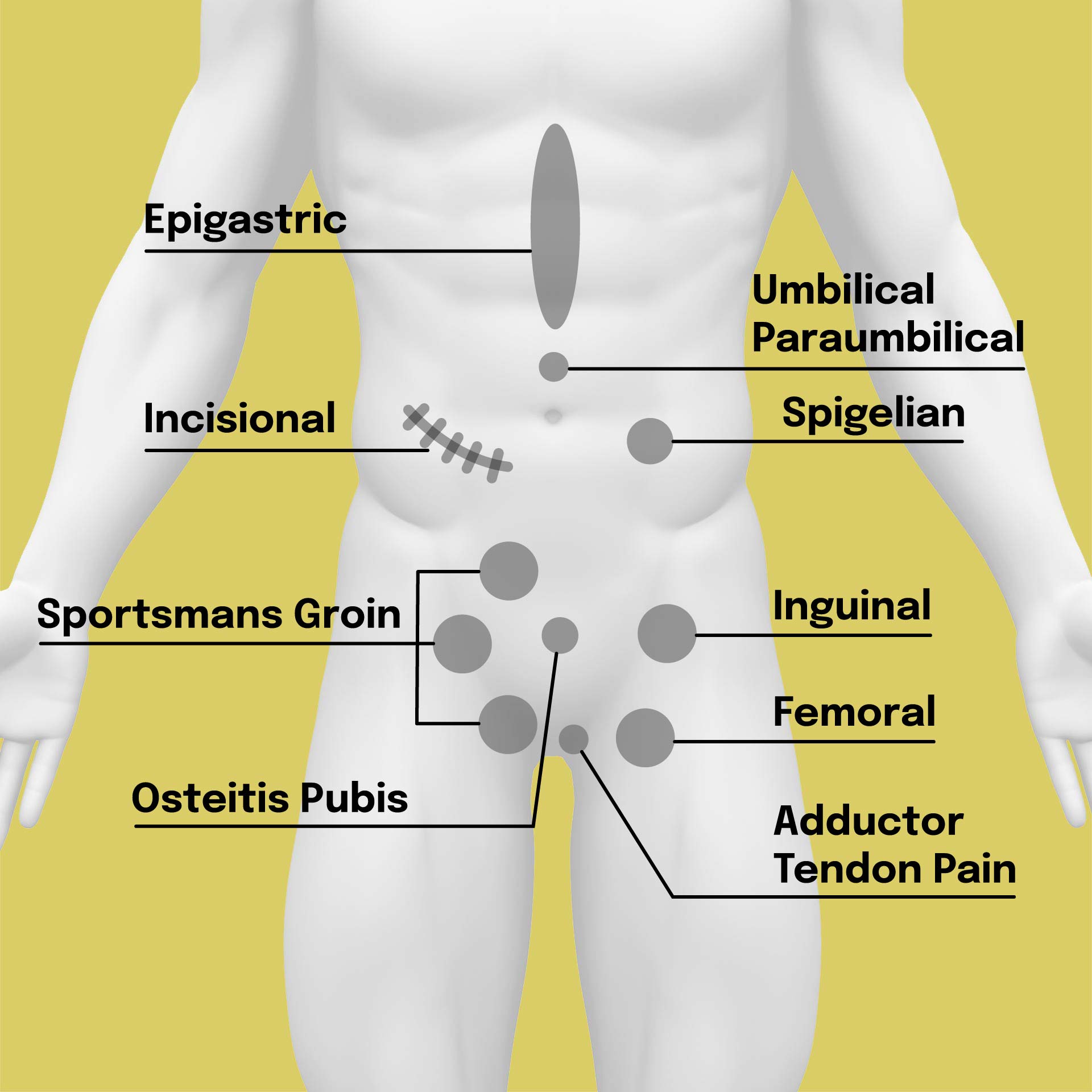Other causes of Groin Pain
Sportsman’s groin, Gilmore’s groin, Sportsman’s hernia, Footballer’s hernia, Pubalgia, Inguinal canal disruption, Sports Hernia, Conjoint tendon disruption.
Several names are given to the condition found in sportsmen and women characterised by groin pain. Symptoms may start during exercise but there is rarely a history of sudden pain. Following exercise, the early stages are characterised by pain and stiffness. The stiffness gradually improves but the symptoms fail to improve despite rest.
The condition was first described by Jerry Gilmore, London in 1980.
Pain is exacerbated by running, jumping, change of direction, coughing and sneezing. It is usually possible in the early stages to continue exercising.
No lump is palpable in the groin, but on close clinical examination, there is often a dilated superficial ring on the affected side.
Ultrasound is helpful. On straining there is a protrusion of the posterior wall of the inguinal canal. The pain in the groin and pelvis can be referred from a number of problems, including injuries to the lumbar spine, the hip joint, the sacroiliac joint, the abdomen, and the genito-urinary system.
Osteitis Pubis
Refers to inflammation of the joint of the symphysis pubis (pubic bone). The inflammation leads to both acute and chronic pain.
It is most prevalent amongst athletes, runners, and footballers and may represent an overuse injury. Symptoms can be so severe that it is not possible to continue exercising.
Osteitis pubis is diagnosed on an Xray. MRI scanning can be very helpful in assessing the severity of the inflammation.
Until recently no treatment was available. Physiotherapy however has developed rehabilitation strategies in the past few years which are proving very effective. Rest and anti-inflammatory agents are recommended. Considerable success has been noted using prolotherapy (glucose and local anaesthetic injection) for those patients who failed to improve with conservative management.
Abdominal strain
An abdominal muscle strain is an injury to one of the muscles of the abdominal wall. This usually occurs in response to excessive stretching. Rectus abdominis and the oblique muscles can all be affected.
As with groin strains, the symptoms are sudden onset of pain, muscle spasms and bruising.
Injuries are usually managed conservatively with rest, ice and analgesia.
You would be advised to see a Physiotherapist who can help you with your recovery.
Groin strain
A groin strain is a common injury for the sportsman, of all abilities. The term usually refers to a injury to one of the adductor muscles or tendons, either in the muscle itself or at its attachment to the pelvis. There are 5 adductor muscles, Adductor magnus, Adductor longus and Adductor brevis, Gracilis and Pectineus. These adductor muscles are found on the upper inner thigh. Their action is to adduct the legs,ie squeeze the legs together.
These injuries usually occur during sprinting, running and kicking.
Groin strains are graded 1-3 depending upon their severity.
GRADE 1 Minor tear <10% of fibres torn
GRADE 2 Intermediate tear <90% of muscle fibres torn
GRADE 3 Major tear 90 – 100% of muscle fibres torn
Injuries are usually managed conservatively with rest, ice and analgesia.
You would be advised to see a Physiotherapist who can help you with your recovery.
Sacroiliac joint dysfunction / Sacroiliitis
The sacroiliac joints are situated at the bottom end of the spine where the sacrum joins to the pelvis. The joints act as shock absorbers for the body whilst standing, walking and sitting.
The SIJ commonly suffers from ‘disorders’, especially from running. These disorders are best described as jamming or restriction to the movement of the joint. As the two SIJs make up two of the three joints of the circular pelvis one of them not working has an impact on the whole circle. Sometimes an unrecognised/untreated issue in the SIJ leads to repeated stress across the pubic symphysis at the front of the pelvis, producing pain and possibly leading to Ostitis Pubis in some cases.
Inflammation of the sacroiliac joint gives rise to sacroiliitis, which is a common cause of unilateral low back pain, with pain extending from the low back into the buttock or thigh.
The pain can extend into the hip and groin, thereby confusing this condition with causes for groin pain.
You would be advised to see a Physiotherapist who can help you with your recovery.
Hip joint
The hip joint can produce pain in younger athletes as well as the more widely recognised Osteoarthritic changes seen in the older community. Hip pain is often felt deep in the front of the groin and can be confused with hernia-type pain. An assessment with an experienced physio in this field will differentiate the problems.
Adductor Tendinopathy
The adductor tendons are a group of muscles which attach to the bottom of the pelvis. Onto the very Pubic bone associated with Ostitis Pubis. This tendon can become damaged and torn, often repeatedly during sports like football. This can lead to a chronic condition which gives pain in the lower groin.
You would be advised to see a Physiotherapist who can help you with your recovery.

